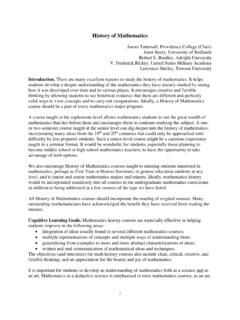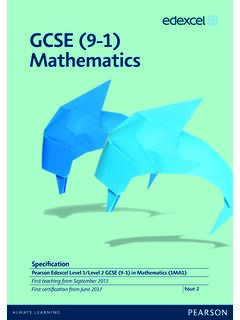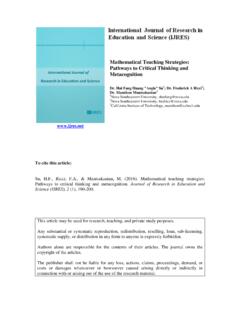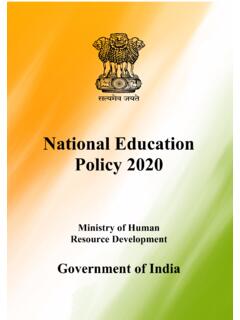Transcription of Understanding Misconceptions: Teaching and Learning in ...
1 26 AMERICAN EDUCATOR | SPRING 2016 Understanding MisconceptionsTeaching and Learning in Middle School Physical ScienceB P M. S G S Everybody wants teachers to be knowledgeable. Yet there is little agreement on exactly what kinds of knowledge are most important for teachers to possess. Should teachers have deep knowledge of the subject matter they are Teaching , gleaned from college study, additional graduate courses, or even research experience? Do they need to understand how students typically think when they approach a problem or theory? Is there some optimal combination of these di erent types of knowledge?
2 Researchers have long speculated that a teacher s knowledge of common student misconceptions could be crucial to student is view recognizes that Learning is as much about unlearning old ideas as it is about Learning new Learners often nd it di cult to change their misconceptions, since these are ideas that make sense to them. Some researchers advocate, therefore, that teachers should know common student miscon-ceptions for the topics that they teach,3 and others suggest that teachers interview4 or test5 their students to reveal student pre-conceptions early on in the Learning process. Yet the research falls short in assessing teachers knowledge of particular student misconceptions and the actual impact of this knowledge on stu-dent discussions as these, if they use data at all, are often based on indirect methods of gauging teacher knowledge.
3 College degrees earned, courses taken, and grades achieved often serve as proxies for a teacher s subject-matter knowledge, which is Philip M. Sadler is the director of the Science Education Department at the Harvard-Smithsonian Center for Astrophysics. His research focuses on assess-ing students scienti c misconceptions; the high school-to-college transition of students who pursue science, technology, engineering, and mathematics (STEM) careers; and enhancing the skills of science teachers. Gerhard Son-nert is a research associate at the Harvard-Smithsonian Center for Astrophys-ics. His research focuses on gender in science, the sociology and history of science, and science education.
4 Is article is adapted from Philip M. Sadler, Gerhard Sonnert, Harold P. Coyle, Nancy Cook-Smith, and Jaimie L. Miller, e In uence of Teachers Knowledge on Student Learning in Middle School Physical Science Classrooms, American Educational Research Journal 50 (2013): 1020 1049. Copyright 2013 by the American Educational Research Association. Published by permission of SAGE Publications, BY JAMES YANGAMERICAN EDUCATOR | SPRING 2016 27identi ed as the general conceptual Understanding of a subject area possessed by a But studies that rigorously investi-gate the relationship between the different kinds of teacher knowledge and student gains in Understanding are set out to better understand the relationship between teacher knowledge of science, speci cally, and student We administered identical multiple-choice assessment items both to teachers of middle school physical science (which covers basic topics in physics and chemistry)
5 And to their students throughout the school year. Many of the questions required a choice between accepted scienti c concepts and common misconceptions that have been well documented in the science education We also asked the teachers to identify which wrong answer they thought students were most likely to select as being correct. rough a student posttest at the end of the school year, we were able to study the impact on student Learning of teacher knowledge of science and the accuracy of their predictions of where students are likely to have all items had very popular wrong answers, but for those that did (12 items of the 20, or 60 percent), we found that teachers who could identify these mis-conceptions had larger classroom achievement gains, much larger than if teachers knew only the correct answers.
6 Is nding suggests that a teacher s ability to identify students most com-mon wrong answer on multiple-choice items, a form of pedagogi-cal content knowledge, is an additional measure of science teacher e ectiveness. For items on which students generally had no popular misconceptions, teacher subject-matter knowledge alone accounted for higher student Study e goal of our study was to test two hypotheses regarding teacher knowledge in middle school physical science courses:Hypothesis 1: Teachers knowledge of a particular science concept that they are Teaching predicts student gains on that 2: Teachers knowledge of the common student misconceptions related to a particular science concept that they are Teaching predicts student gains on that assessed teachers subject-matter knowledge and their knowledge of students misconceptions in the context of the key concepts defined by the National Research Council s (NRC) National Science Education Standards and measured their rela-tionship to student Learning .
7 * We administered the same multiple-choice items to both students and teachers. And we asked teachers to identify the incorrect item (that is, the student misconception) that they believed students would most often select in lieu of the correct answer. is method allowed us to simultaneously evalu-ate the teachers knowledge of both subject matter and students misconceptions and examine if these teacher measures predict student gains in middle school physical science learners often struggle with misconceptions, and multiple-choice tests function well in diagnosing popular mis-conceptions that can impede the Learning of science Good examples include the causes of the seasons and of the phases of the moon.
8 For instance, a particularly common view, often held by adults, is that the seasons are caused by the earth s elliptical orbit rather than the changing angle of the sun s rays hitting the surface of the earth. In the documentary A Private Universe, bright and articulate graduating college seniors, some with science majors, revealed their misunderstandings of such common middle school science If teachers hold such misconceptions themselves or simply are unaware that their students have such ideas, their attempts to teach important con-cepts may be measured gains on key concepts during a one-year middle school physical science course.
9 As is common in this type of research, we controlled for di erences in student demographics, such as race, ethnicity, home language spoken, and parents education. By using indi-vidual test items, we could assess how strongly teachers subject-matter knowledge and knowledge of students misconceptions were associated with student study design was also able to account for the amount of physical science content taught during the middle school years, which can vary greatly. While some schools devote an entire aca-demic year to the subject, other schools include physical science within a general science sequence that covers earth and space science and life science.
10 Also, we were concerned that the initial science achievement of participating classrooms might obscure any changes in student achievement during the school year. For example, it may be that, compared with their less experienced colleagues, more experienced or expert teachers were assigned students who have shown higher prior achievement. Administer-ing a pretest, a midyear test, and a posttest enabled us to control for students baseline knowledge initial nationwide recruitment e ort yielded 620 teachers of seventh- and eighth-grade physical science at 589 schools (91 percent of which were public). Of the teachers who at rst volun-teered to be part of this study, 219 followed through.
















